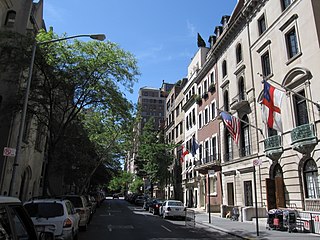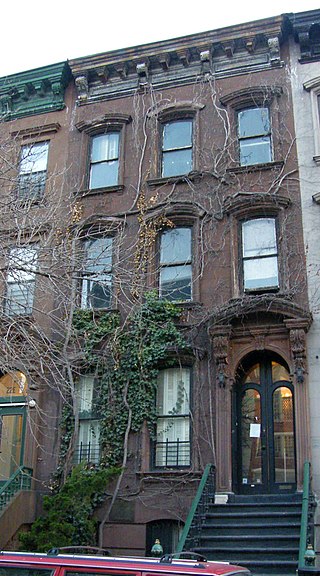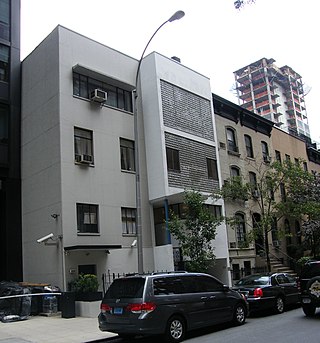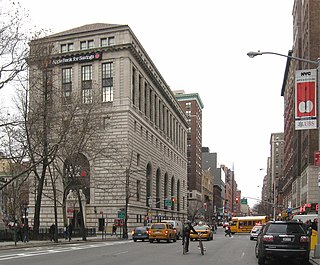The New York City Landmarks Preservation Commission (LPC), formed in 1965, is the New York City governmental commission that administers the city's Landmarks Preservation Law. Since its founding, it has designated over a thousand landmarks, classified into four categories: individual landmarks, interior landmarks, scenic landmarks, and historic districts.
The New York City borough of Manhattan contains numerous landmarks designated by the LPC, as well as seven scenic landmarks and several interior landmarks and historic districts. The following lists are split by geographical region.

Fifth Avenue is a major and prominent thoroughfare in the borough of Manhattan in New York City. It stretches north from Washington Square Park in Greenwich Village to West 143rd Street in Harlem. It is one of the most expensive shopping streets in the world.

The New York City Landmarks Preservation Commission (LPC) is the New York City agency charged with administering the city's Landmarks Preservation Law. The LPC is responsible for protecting New York City's architecturally, historically, and culturally significant buildings and sites by granting them landmark or historic district status, and regulating them after designation. It is the largest municipal preservation agency in the nation. As of July 1, 2020, the LPC has designated more than 37,000 landmark properties in all five boroughs. Most of these are concentrated in historic districts, although there are over a thousand individual landmarks, as well as numerous interior and scenic landmarks.

The Dyckman House, now the Dyckman Farmhouse Museum, is the oldest remaining farmhouse on Manhattan island, a vestige of New York City's rural past. The Dutch Colonial-style farmhouse was built by William Dyckman, c.1785, and was originally part of over 250 acres (100 ha) of farmland owned by the family. It is now located in a small park at the corner of Broadway and 204th Street in Inwood, Manhattan.

St. Andrew's Episcopal Church is a historic Episcopal church located at 2067 Fifth Avenue at 127th Street in the neighborhood of Harlem in Manhattan, New York City. Built in 1872, it was designed by noted New York City architect Henry M. Congdon (1834–1922) in the Gothic Revival style. It features a 125 foot tall clock tower surmounted by a slate covered spire surrounded by four towerlets.
This is intended to be a complete list of properties and districts listed on the National Register of Historic Places on Manhattan Island, the primary portion of the New York City borough of Manhattan, from 14th to 59th Streets. For properties and districts in other parts of Manhattan, whether on Manhattan Island, other islands within the borough, or the neighborhood of Marble Hill on the North American mainland, see National Register of Historic Places listings in Manhattan. The locations of National Register properties and districts may be seen in an online map by clicking on "Map of all coordinates".
This is intended to be a complete list of properties and districts listed on the National Register of Historic Places between 59th and 110th Streets in Manhattan. For properties and districts in other parts of Manhattan and the other islands of New York County, see National Register of Historic Places listings in Manhattan. The locations of National Register properties and districts may be seen in an online map by clicking on "Map of all coordinates".
List of the National Register of Historic Places listings in Manhattan above 110th Street

The Upper East Side Historic District is a landmarked historic district on the Upper East Side of New York City's borough of Manhattan, first designated by the city in 1981. It was listed on the National Register of Historic Places in 1984. Its boundaries were expanded in 2010.
These are lists of New York City landmarks designated by the New York City Landmarks Preservation Commission:

The Van Tassell and Kearney Horse Auction Mart is a building in East Village, Manhattan, New York City. The building was constructed in 1903-04 to the designs of Jardine, Kent & Jardine in the Beaux-Arts Style. It originally served as a horse auction mart that catered to New York's elite families, including the Vanderbilts and Delanos. Each Tuesday and Friday, Van Tassell & Kearney held auctions in the building. Though carriages remained an important part of the business, most advertisements and newspaper stories about the mart concerned the sale of horses, particularly high-priced ribbon winners, polo ponies, hunters, and thoroughbreds. Other sales were devoted to breeding stock and coach horses, including a large group of horses co-owned by Alfred W. Vanderbilt and Robert L. Gerry in 1906.

Langston Hughes House is a historic home located in Harlem, Manhattan, New York City. It is an Italianate style dwelling built in 1869. It is a three story with basement, rowhouse faced in brownstone and measuring 20 feet wide and 45 feet deep. Noted African American poet and author Langston Hughes (1902-1967) occupied the top floor as his workroom from 1947 to 1967.

The Lescaze House is a four-story house at 211 East 48th Street in the East Midtown and Turtle Bay neighborhoods of Manhattan in New York City. It is along the northern sidewalk of 48th Street between Second Avenue and Third Avenue. The Lescaze House at 211 East 48th Street was designed by William Lescaze in the International Style between 1933 and 1934 as a renovation of a 19th-century brownstone townhouse. It is one of three houses in Manhattan designed by Lescaze.

The Apple Bank Building, also known as the Central Savings Bank Building and 2100 Broadway, is a bank and residential building at 2100–2114 Broadway on the Upper West Side of Manhattan in New York City. Constructed as a branch of the Central Savings Bank from 1926 to 1928, it occupies a trapezoidal city block bounded by 73rd Street to the south, Amsterdam Avenue to the east, 74th Street to the north, and Broadway to the west. The Apple Bank Building was designed by York and Sawyer in the Renaissance Revival and palazzo styles, patterned after an Italian Renaissance-style palazzo.